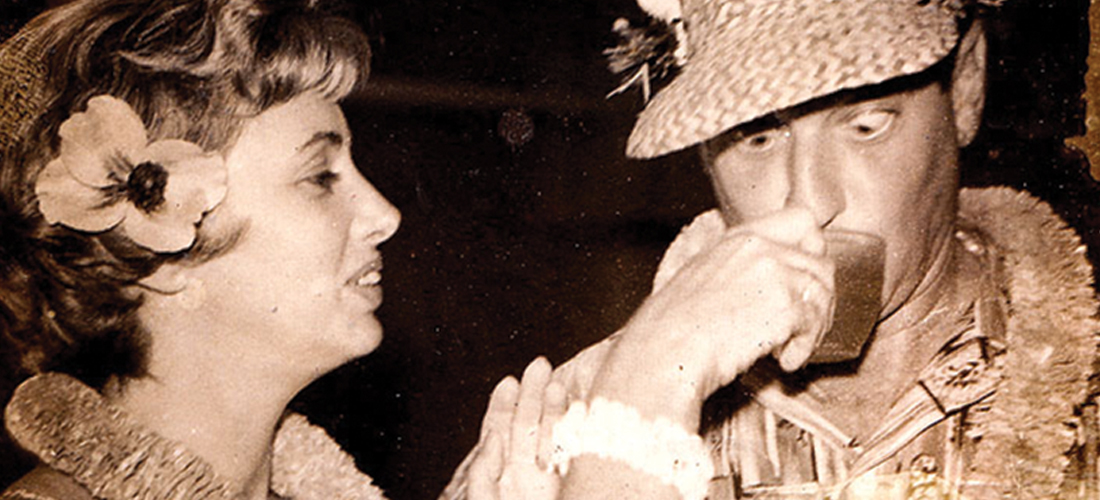Greensboro’s Next Wave
One simply needs to look around town to realize that Greensboro is on the move — the Next Wave of young and creative people are already shaping the Gate City’s future. We thought you’d like to meet a few of them
Photographs by Mark Wagoner
 Cooking Up Change
Cooking Up Change
Table Seven needs a birthday dessert, a pavlova.
On the hot side of the counter that divides the cooks from the customers at Chez Genèse (pronounced zhu-NEZ), owner-chef Kathryn Hubert centers a beige cake made from meringue on a small white plate — its magnificent foamy peaks and furrows baked into place by a brief encounter with a furious oven.
She slaps the creation with a heavy spoonful of homemade whipped cream. Her gloved hands rain blueberries and blackberries over the gleaming pond. The inky berries land with soft plops.
She rocks a chef’s knife on cutting board to yield juicy geodes of strawberries, then she upends a tin canister of powdered sugar and makes it snow over crags of red and blue.
“Runner!”
Server Ben Lugo, who describes himself as autistic, carefully lifts the plate from the counter and takes a few steps to present it to the honoree.
“Happy birthday to you, happy birthday to you, I forget the rest of the song, buhhhhhhht . . . HAPPY BIRTHDAY TO YOU!”
What Lugo lacks in words, he makes up for with enthusiasm. Laughter bathes the moment.
Lugo, 22, laughs, too.
Behind the counter, the oval-faced owner Hubert, who traps her long brown hair under a trucker cap, frees a giggle. She is prematurely calm at 30.
“That’s great,” she says of Lugo’s improvisation. “I’ve never seen him do that before.”
Ten years ago, when she was chipping away at a degree in hospitality management at UNCG, Hubert imagined her future.
She could see herself leaving Greensboro for Oregon.
Maybe Portland. Someplace awash in young people who wanted to make the world a better place.
Sustainable. Fair. Inclusive.
Those were her values.
But another thought tapped at her mind as she pondered what might be elsewhere: There was plenty of work to be done here.
“There were people walking by me every day that needed help,” she says.
Living on the cusp of campus and downtown, she saw homeless people frequently. She worked in a community garden in the Glenwood neighborhood, where families prized the vegetables that sprang from the dirt. She tutored children in an after-school program run by the nonprofit Hope Academy and, later, in a similar one operated by the Autism Society of North Carolina. That’s where she met Joey, a profoundly autistic boy whom she describes as “very sweet, very in tune.”
Hubert was on familiar ground. She’d grown up with three male cousins with autism, a wide-ranging condition marked by difficulty in making social connections.
Portland would have to wait. After graduating from UNCG, she stuck around for Joey. She became his full-time assistant at his elementary school, a paid position in the school system.
The job with Joey was rewarding — for him, and for her — but when Hubert looked ahead, as she is prone to do, she saw a sad truth: The Earth is, indeed, flat for people like Joey, who often fall off the edge once they leave high school and find that job opportunities for people with intellectual and developmental disabilities are practically nil.
Once again, she pitched herself into the future and saw a solution: a French cafe that would employ people with intellectual and developmental disabilities — folks like Joey and her cousins.
Hubert was a foodie from way back. Coming of age in the mountain college town of Boone, she cooked at The Inn at Crestwood and Hound Ears Club. She bagged a degree in culinary arts from Caldwell Community College and spent a year volunteering in a resort kitchen in the Burgundy region of France.
The experience left a lasting impression.
“I fell in love with French food and culture, and how generous French people are with their time. They’re very relational,” she says. “When they invite you into their homes, there’s no time limit on it.”
Her experience propelled her to study hospitality at UNCG, which led her, in turn, to meet Joey, which led her to understand that she could whisk together everything she had learned — about food, about people with disabilities, about being the change she wished for — to create an inclusive workplace.
“This has been a dream a long time in the making,” she says.
She toned her restaurant chops by working in catering at the Iron Hen and, later, by helping to get the now-shuttered Morehead Foundry complex off the ground.
She cultivated a coterie of advisers: an attorney, an interior decorator, small business owners and fellow chefs.
The stove jockeys devised a menu rooted in Gallic ethos.
“The French don’t cram a lot of ingredients into their food,” she says. “They pick a few and let them shine.”
The breakfast-and-lunch offerings would glow with fresh baguettes, croissants and brioche from Camino Bakery in Winston-Salem.
House-made egg dishes would wear simple accessories: asparagus and chèvre; smoked salmon and dill crème fraîche; spinach, roasted red potatoes and Camembert.
Strawberry crepes would travel with crème fraîche or Nutella.
Ham and butter on a chewy baguette would equal a sandwich.
A fancy sandwich might combine olive tapenade, fresh tomatoes, goat cheese, sliced chicken, pepperoncini and arugula on a baguette.
A tart might require just potatoes, thyme and red onions.
Chocolate mousse would leave tiny air pockets in a small mason jar and wear a fluffy hat of whipped cream.
Hubert stitched together financial backing from various sources: family and friends; online crowdfunding campaigns; grants from downtown development advocates; and a personal loan of $30,000.
She secured a location on the southern hem of downtown — an airy space which last held PB&Java, a sandwich and coffee shop near the corner of South Elm and Bain streets, a block removed from Gate City Boulevard.
She didn’t have to advertise for applicants. After local media announced her plans, emails rolled in from people who wanted a job. If parents contacted her on their children’s behalf, Hubert asked them to have their children contact her directly. Applicants had to want it for themselves. She wasn’t in the business of handing out jobs. She was in the business of hiring people who could do the job, never mind their disabilities.
She conducted interviews, culled the best candidates, and arranged for job training with lots of role-playing and explicit instructions on how to read and react to social cues, a common deficit among people with developmental issues.
Among the lessons: Do not interrupt when customers are deep in conversation; and when diners set their plates aside or their silverware on their plates, assume they’re probably be finished. There were moments of levity.
Once, when Hubert played the role of a diner, a would-be server asked if she wanted dessert. Sure, she said. What are your favorites? Impulsively, he proceeded to tick off a litany of sweets that weren’t on the menu.
She then diplomatically reminded him that the context called for a list of confections that were available to diners.
One of her cousins helped with the training.
“He said, ‘Hey, I’m Zachary. I’m autistic, and I’m not ashamed of it,’” she says. “There was an immediate connection between him and the staff because they thought, ‘He understands.’”
Hubert mobilized an army of volunteers to blanche the restaurant’s interior to simple chic. They painted the walls white, wrapped support columns in rope, hung sail cloth drapes in the many windows, and striped the walls with shiplap siding and floating shelves that breathed with terra cotta pots, feathery ferns and trailing tendrils.
A friend hung a banner of brown butcher paper near the front door. In wispy script, she translated the cafe’s French name:
“Chez Genèse, A Place of New Beginnings.”
Hubert’s mom and dad, Lori and Barry, came from Boone and camped in the construction zone, lending muscle and experience. Convinced that she could never pay back, only pay forward, their love, Hubert planted one white chair in a sea of black bistro seats. The first person to occupy that seat every day gets a meal on the house, along with a brief history of the reason behind the largesse.
“It seemed like a good way to share the story, in a practical way,” says Hubert.
She opened her breakfast-lunch cafe in late-October, the same week that A Special Blend, a coffee shop that also employs adults with cognitive disabilities, opened on West Market Street near Starmount Forest (see this month’s Life’s Funny, page 17).
It was a coincidence. But Hubert believes the events are rooted in the same time and place. It’s a time, she says, when people who are inclined to quash employment barriers for those with disabilities have successful role models like Wilmington coffee shop-turned-franchise Bitty and Beau’s.
Greensboro, she says, is fertile ground for people like that.
“There is, I think, a sense of community in Greensboro that isn’t in other places,” she says. “I think there are a lot of businesses and individuals here who care about making an impact, and I’m honored to be a part of that.”
More than half.
That’s how many of Hubert’s 22 employees deal with evident disabilities: autism, Down syndrome, lower-than-average IQs, and other conditions that make processing information a challenge.
Brianna Oliver, 21, says she deals with attention deficit and hyperactivity disorder, anxiety and depression. She graduated from high school, tried college for a while, and lost a job as a preschool assistant before coming to Chez Genèse.
“I’m either all too much at once, or not engaging enough. It’s hard to be myself with people because I feel like they won’t want to be friends with me,” she says.
At Chez Genèse, she says, she can be herself, knowing that her bosses — Hubert and her neuro-typical lieutenants — understand and can help if needed. As a result, Oliver has relaxed into her job as server, a job she wanted so she could improve her social skills.
Katya Hedrick, 25, a prep cook, left her parents and a job helping with horseback tours in Boone to see if she would like living on her own.
“I already knew I wasn’t good at talking to people, so I’m learning to communicate better. When I came to Greensboro, I had to talk more,” she says deliberately.
The change was scary, she admits, but chocolate croissants and supportive co-workers have made it easier. Also, they have helped her refine one of her best skills: hugging.
“This is like a big family that tries to help one another,” she says.
Lugo, the birthday crooner, also tried college. It didn’t work out, he says, so he now works four jobs, three in food service.
Ask him what’s good about working at Chez Genèse, and he shifts to the hypothetical second-person to answer.
“If you were a jerk, or pardon my French, an asshole, you would say the pay and no tips,” he says, referring to the slightly-better-than-minimum-wage pay and no tipping in the French tradition.
But because Lugo is not a sarcastic asshole, he will say no such thing. Instead, he will say that Chez Genèse has allowed him to see a future job that might involve his passion: games. Online games, board games, trading card games. He’s good at memorization. Show him the rules, and watch him go.
“It got me thinking, maybe I’ll open a store and help people,” he says.
— Maria Johnson
 Katei Cranford – Community Advocate
Katei Cranford – Community Advocate
A tireless purveyor of everything local, Greensboro gadfly Katei Cranford wears a lot of hats, none of them boring: Event organizer. Historic preservationist. City council candidate. Yes! Weekly columnist. Radio DJ. Social media flamethrower.
Where does the 34-year-old get all her energy? “There’s a certain inspiration that comes with the frustration of not necessarily being a city that has a lot going on.”
Many will know her best from her long-running Tuesday afternoon radio program on WUAG that spotlights musical groups playing around North Carolina.
Instant Regrets and Basement Life are local faves but Katei confesses, “A lot of the bands I’m most excited about are coming out of Raleigh right now.” That’s because a viable music scene is predicated on a platform of appropriate entertainment venues, so she’s often engaged in nudging developers into expanding creative outlets and performance spaces. “It can be really fun here and I want to share that. And everybody else I talk to does too,” she says.
Things are looking up on the music scene, Cranford says: “When you get solid touring bands coming here there’s an extra element of passion and enthusiasm. We don’t take them for granted.”
Like they say: Right what you know. — Billy Ingram
 Witneigh Davis & Giovanni Ramadani – Founders Greensboro Fashion Week
Witneigh Davis & Giovanni Ramadani – Founders Greensboro Fashion Week
Lights! Cameras! Music! Yes, Greensboro Fashion Week has all the glamour and excitement one would expect from a runway show, but for founders Witneigh Davis and Giovanni Ramadani, it has always been as much about substance as style, starting with their initial vision in the fall of 2014.
New York Fashion Week, says Giovanni, a former model, had become “watered down” and rife with pay-to-play participants.” Gotham “got outside the major designers they’re showcasing.” Talent was secondary. Greensboro, on the other hand, boasted “textiles driving industry back in the ’60s,” says Witneigh, a former stylist with marketing chops. “Knowing that the history and roots were here in the fashion world, we just kind of resurfaced in a modern way.”
The two entrepreneurs saw an opening to fill the fashion gap in the Southeast, between New York and Miami, by showcasing local designers with the help of sponsors, such as Greensboro’s Foreign Cars Italia and no less than Bentley, among others. After all, as Witneigh points out, clothes and cars are “a natural fit.” She and Giovanni also noticed that Greensbororians sported their own polished and casual, if a bit subdued style, and could be encouraged to take more daring sartorial steps.
Fast-forward five years, and the two entrepreneurs, both of whom who will be 32 this year, will tell you GFW has morphed beyond expectations, becoming a true platform for fashion. Designers — from all over the world — are vying for the opportunity they’ve provided. “We had over 100 applicants last year and we only had room for eight,” says Giovanni. “We wanted to pick the best ones.” And they are hands-on. Witneigh says the two constantly communicate with the designers by Skype, every step of the way before the razzmatazz in fall that includes multiple shows at various hip locations around town. (Last year they snagged a hangar at Honda Jet for one of their shows.)
But Witneigh and Giovanni haven’t stopped there: They started a modeling camp for kids in the summer, the first, Giovanni believes, in North Carolina, to teach aspiring models the ins and outs of the industry and how to comport themselves professionally so as to be agency-ready. (Some were signed on at last year’s Fashion Week.) The dynamic duo are also putting their energies behind Twin City Fashion Week in Winston-Salem this spring and a daylong Summer Show before the GFW revs up again in October.
They’re excited that the event is becoming a destination. “That’s the thing,” says Giovanni. “We want to make Greensboro cool. We want to make Greensboro fashionable. We want to make Greensboro fun.” — Nancy Oakley
 Maurice Hicks – Filmmaker
Maurice Hicks – Filmmaker
It takes a visionary to see life’s big picture, then project it on the big screen. Just months ago, UNCG film grad Maurice Hicks, 32, completed a feature film he wrote and directed, Rap and Rhyme, an underbelly exam of the music biz, which he says is “an accurate reflection of who I am as a person, an artist, and what I’m capable of.” As a financial and artistic roll of the dice, “it was absolutely terrifying but we did it.”
Timing seems right. His highly acclaimed short from a few years ago was recently picked up by an entertainment channel, a circumstance so rare as to be almost unheard of. An unflinching commentary on American racial injustice, A Letter To My Son stars Cranston Johnson (Hap and Leonard), who’ll be seen in two new series on ABC and Netflix this year.
It takes a creative fervor to be constantly producing in spite of overwhelming uncertainty, but it’s paying off. “I like Hip Hop, I like urban characters,” Maurice says. “I grew up in an urban environment so I like to think I write them pretty authentically.” Hollywood agrees. Maurice currently has a major motion picture being shopped around with Outkast’s Big Boi attached.
Meanwhile, his latest movie treatment, about romance in the digital age, is a finalist for Best Screenplay at the South Carolina Underground Film Festival. “I’ve never been to Charleston,” the filmmaker confesses. “It should be fun.” — Billy Ingram
 Jessica Mashburn – Singer, Songwriter
Jessica Mashburn – Singer, Songwriter
The next time you see her, you might be forgiven if you fail to recognize Jessica Mashburn, the gifted chanteuse whose physical appearance seems to change like the weather. Long a favorite among patrons of Proximity Hotel’s Print Works Bistro, which hosts the popular Wednesday night jazz gigs, the 36-year-old Mashburn performs with partner Evan Olson, not to mention countless events ranging from private parties to splashy weddings. The colorful and chameleon-like songwriter-songstress might be the closest thing in the Triad to a musical theater Renaissance woman. One minute she’s a sultry Berlin cabaret singer from the 1930s, the next a blonde bombshell à la Some like it Hot.
“I love to adapt to whatever is needed the more dramatic the better,” she says. “If someone needs a flapper from the ’20s to greet people and sing them through the door, hey, I’m just the person.” That’s because she sees herself primarily as an entertainer: “My job is to leave folks happy and maybe even inspired.”
Born the daughter of bluegrass musicians from Southern Pines who relocated to Greensboro in 1984 to give their precious daughter “a better exposure to the arts,” Jessica thrived in theater and music at Southeast Guilford before enrolling at UNCG to study music. The large classes prompted her to switch to her hometown, Sandhills Community College, where she sang with the jazz band, taught herself piano and guitar, and earned a degree in music before moving for a brief time to Raleigh to work for Quaintance-Weaver’s Lucky 32 Restaurant, having been a server at the Green Valley Grill during her time at UNCG.
The divine Miss Mashburn’s versatile talents led to a post at the O.Henry Hotel as events manager in 2005, a job she performed until 2007 (singing on weekends with pianist Dave Fox), when Dennis Quaintance recruited her for the design team of the sister Proximity Hotel. In 2011, this musical polymath who makes her own outrageous hats, “demoted” herself back to server in order to free up weekends for performing — and never looked back. Though she still works as the hotel’s music coordinator, her career has soared like a bird.
“Funny you should say that,” she quipped on a recent afternoon wearing a hairdo done to look like a maple tree in autumn splendor. “My favorite song with Dave is ‘Feed the Birds’ from Mary Poppins. That was Walt Disney’s favorite song. I love to sing it because Greensboro is such a special place and feeds me in a spiritual way.” She went on to say that the Gate City is “a place where artists are welcomed and encouraged. I feel so lucky to be here.”
So do we, dear Jessica. — Jim Dodson
 Savio Nazareth – Head Professional, Starmont Forest Country Club
Savio Nazareth – Head Professional, Starmont Forest Country Club
Savio Nazareth was 7 when he first played golf in his native Tanzania. “I hated golf. I was much more into soccer as a kid,” he says with a laugh. “Funny how golf took me to places I could never have imagined.”
It was indeed a long and winding road to venerable Starmount Forest Country Club, where Savio, 39, is completing his first year as club’s eighth head professional in 2018.
His story is one of an East Indian family and great faith — plus times that are a’ changing. In his teens, Savio began winning golf tournaments in Africa and started to think seriously that golf might be his ticket out of Tanzania. His parents arranged for him to attend school and live with his older brother Andrew in Orlando, Florida, where he found a spot on the school golf team. After a stint at junior college, he was recruited by Guilford College’s late beloved coach Jack Jensen, who found scholarship money, guided him through some tough academic transitions and helped him land a sports internship at Southeast Guilford High. “Jack got me through some difficult times. He was more than a mentor to me,” Savio says with emotion. “He was like a father figure.” In 2002, Savio helped guide Guilford College to the National Collegiate championship.
After college he played two years on the Hooters Tour and enjoyed some success, but was soon married and looking for something more stable than the vagabond life of a touring pro. In the spring of 2005, he found a gig as assistant to Starmount Forest’s head man Eric Gaskell, a post he held for the next decade. Popular with the club’s golfing members, Savio qualified for his first Wyndham Championship in 2008 and started seriously thinking about earning his class-A PGA credentials.
The critical moment came in 2016 when he lost his mother, Sabina, and brother Andrew, just five months apart — and almost his desire to play golf. “I spoke to my mother almost every day, and I owed my brother so much for his support. Losing them was devastating. I felt lost.”
The one thing that kept him going, he says, was wife, Lisa, and their two children, Hillary and Trent, along with guidance from his minister at Shady Grove Wesleyan Church in Colfax. “They helped me see that everything has a purpose and you simply have to keep going and keep the faith that you’re on the right path.”
That faith was redeemed at the PGA Sectional Championship in Wilmington when Savio — thinking of his late brother — rolled in a 4-foot putt to claim the title and went on to win Sectional Player of the Year Honors, earning his exemptions in several major professional tournaments. “I cried like a baby,” he allows.
Maybe the biggest prize came last year, however, when Starmount Forest’s head man Bill Hall retired and Savio Nazareth was rewarded with the top job.
“It’s 13 years and been an amazing journey here, and I’m still learning more every day. This place is really a big family to me. The club has enjoyed a great revival of young families and I’m just honored to be part of that new phase of life.” — Jim Dodson
 Jessika & Veronika Olsen – Owners, Sonder Mind & Body
Jessika & Veronika Olsen – Owners, Sonder Mind & Body
Flotation Therapy, something Tom Brady and Gisele Bündchen practice, offers the extraordinary opportunity to experience weightlessness without entering outer space, thanks to 1,000 pounds of epsom salts (magnesium sulfate) added to a pod containing warm H2O. (The pod contains the same amount of magnesium sulfate as the Dead Sea.) My friend Stephanie Bolton, who calls herself a floater, finds that it takes you to inner space.
But to get there you’ll have to venture to Sonder Mind and Body on South Elm Street. The wellness center offers flotation along with infrared sauna, massage, hypnosis, yoga and an organic café.
Identical twins Jessika and Veronika Olsen, 33, believe their health spa and café is one of only two nationwide (the other opening in hipster capital, Austin, Texas). Both sisters battle autoimmune disease. Veronika previously operated a wellness clinic in Hawaii. Jessika owned a bakery business. Since age 19, they have been entrepreneurial with a focus upon wellness. Their mother, a nurse, promoted flotation, having experienced it.
“Flotation is not like anything most have tried,” explains Jessika. “It takes you away from all external things.”
I had to give this a try.
Following infrared sauna, I showered in a private room and with a twinge of trepidation entered the pod after a tutorial from Veronika. Initially I kept the lid open, but as soon as the lights dimmed, I closed it so that I was in a completely dark environment.
If the womb was this exhilarating, how did Mother Nature coax me out? Sixty minutes passed in luxurious slow-mo. My skin felt silken, limbs wondrously weightless, and I was suspended in honeyed, liquid quiet.
Floating reduces anxiety in veterans who suffer from post-traumatic stress, and gives others relief from pain. It offered me meditative calm; utterly, peacefully transporting.
“We don’t want anyone to stress about relaxing,” smiles Jessika.
The original Olsen twins are Greensboro’s newfound treasure. And I’m now a floater, too. — Cynthia Adams
Sonder Mind and Body, 515 S. Elm St., (336) 663-7562 www.SonderMindandBody.com
 Joe Rotondi – Executive Director, Forge Greensboro
Joe Rotondi – Executive Director, Forge Greensboro
Once upon a time, Joe Rotondi’s great ambition in life was to work as a bartender all across America, meeting the locals. “Bartending is a great way to take the pulse of a community and really learn what’s going on,” says the friendly 33-year-old. It was his love of people that led him to volunteerism and community development for nonprofits — and eventually studies in social entrepreneurship at UNCG, where he’ll pick up a degree this spring.
Several years back, Joe’s interest in making a bench for City Market led him to Forge Greensboro, an innovative makerspace. At the time it was just off West Lewis Street in a former turn-of-the-century blacksmith shop — hence the name — in a once forgotten part of downtown. What he found there spoke powerfully to his inner community developer — a shared place. There, budding inventors, artisans, trade professionals, tinkerers, entrepreneurs or simple hobbyists could create, learn, collaborate and produce just about anything they could imagine for a simple monthly fee that provides access to proper workspace, advanced tools, and the collective wisdom of a hands-on creative community.
Joe Rotondi came aboard as facility manager in late 2014 not long before robust membership growth prompted a move to a building on Lewis Street that once served as an auxiliary livery stable and more than doubled the Forge’s usable space, becoming an anchor of the area’s spectacular transformation. Now as executive director, he oversees a grass-roots powerhouse that boasts 195 members and has launched at least 30 different businesses in just five years of existence. On any given day, at any hour, you’re likely to find an inventor of an electric car hard at work on a high-tech 3-D laser machine or a class underway in the brilliantly equipped woodshop. Since opening, the Forge has taught more than 700 diverse classes and skills to nearly 2,000 students of all ages and backgrounds.
“The real beauty of this place is its diversity and the people,” says Joe, who points out that a recently completed capital campaign raised $200,000, funds that will go in part for teaching grants and more advanced equipment for budding engineers, welders, furniture makers, or, who knows, maybe the next Elon Musk. “The Forge’s diversity is its strength, a place designed to teach, share and grow a community by hand,” Joe allows as he leads a visitor through the various workspaces where members are making their dreams take shape, followed by his “shop dog” Mira, a friendly cattle dog he saved from an Alabama kill shelter last August.
“She’s found a home here,” Joe reports. “And so have a lot of very talented people.” — Jim Dodson OH
“In our January issue, we misidentified Starmount Forest Head Professional Savio Nazareth’s lovely wife, Hillary, as his daughter. In addition, he only has one child, a promising young golfer named Trent. We regret this error and seriously deserve a two-stroke penalty.” — The Editors
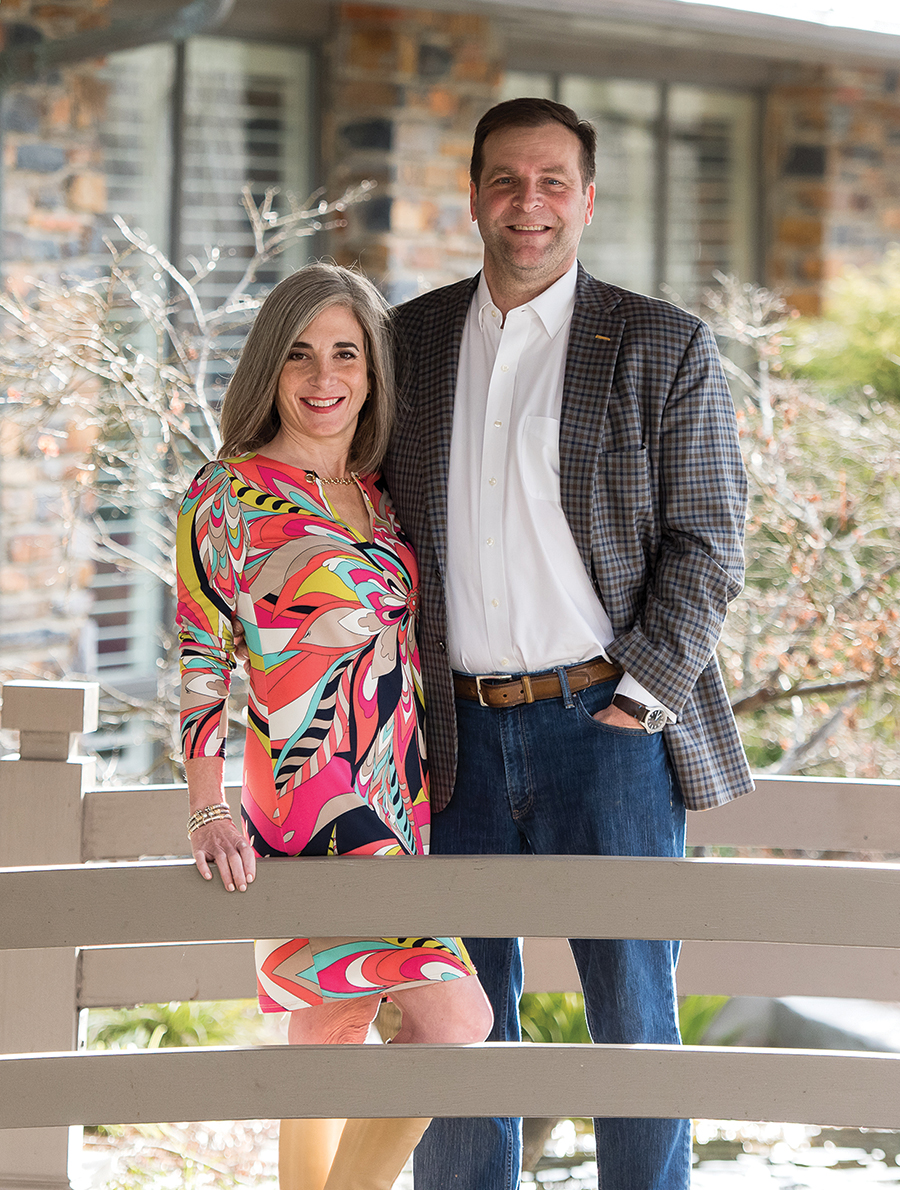
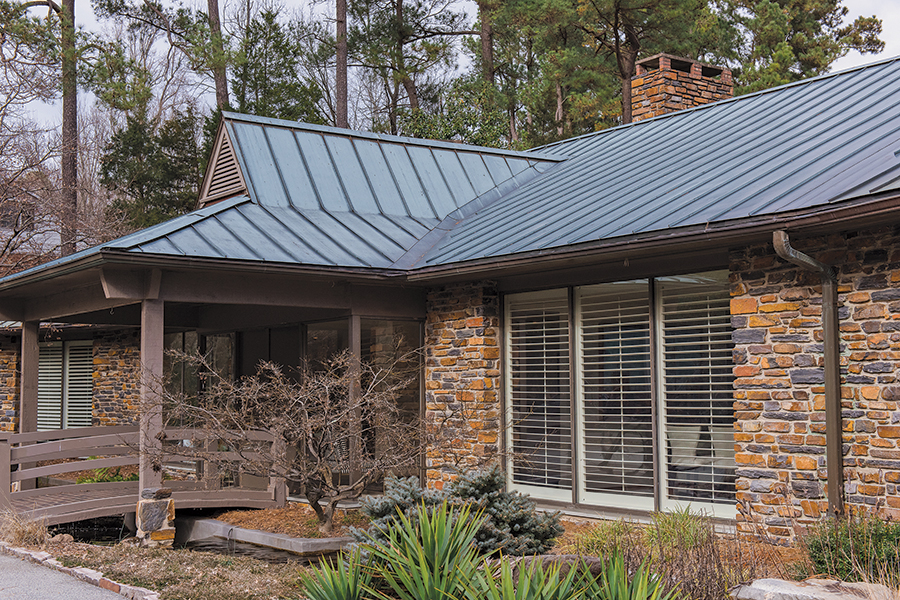















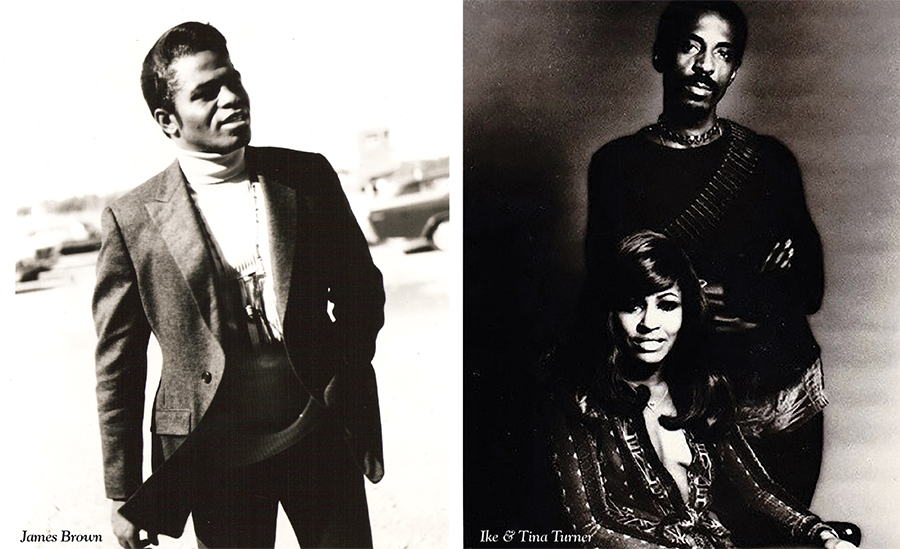
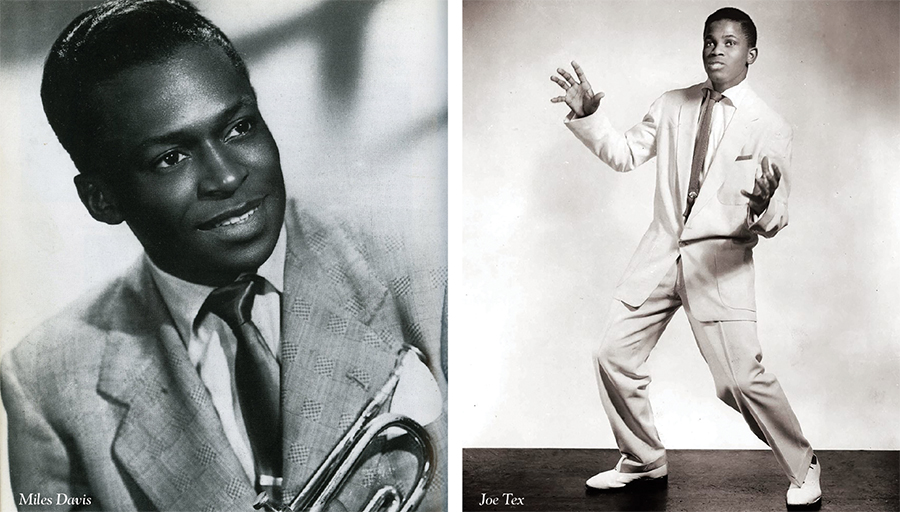
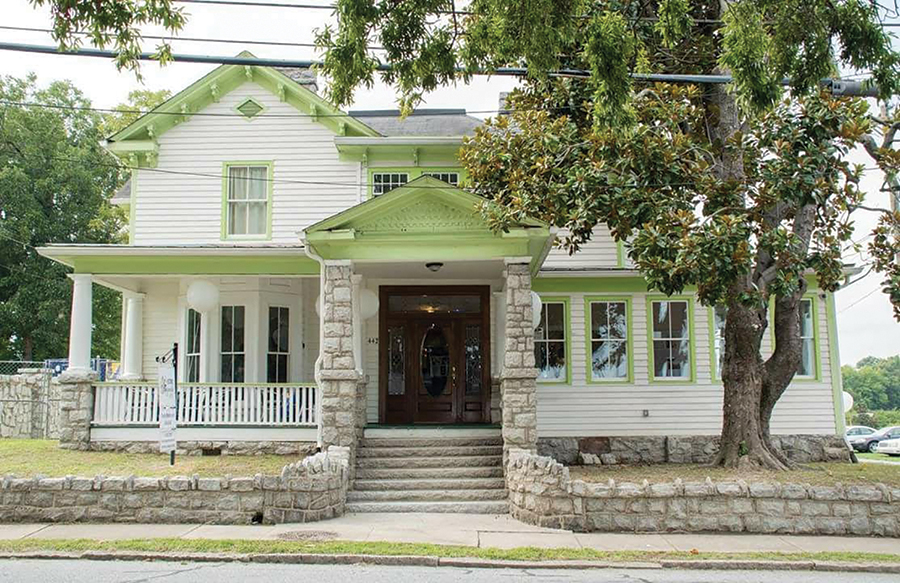
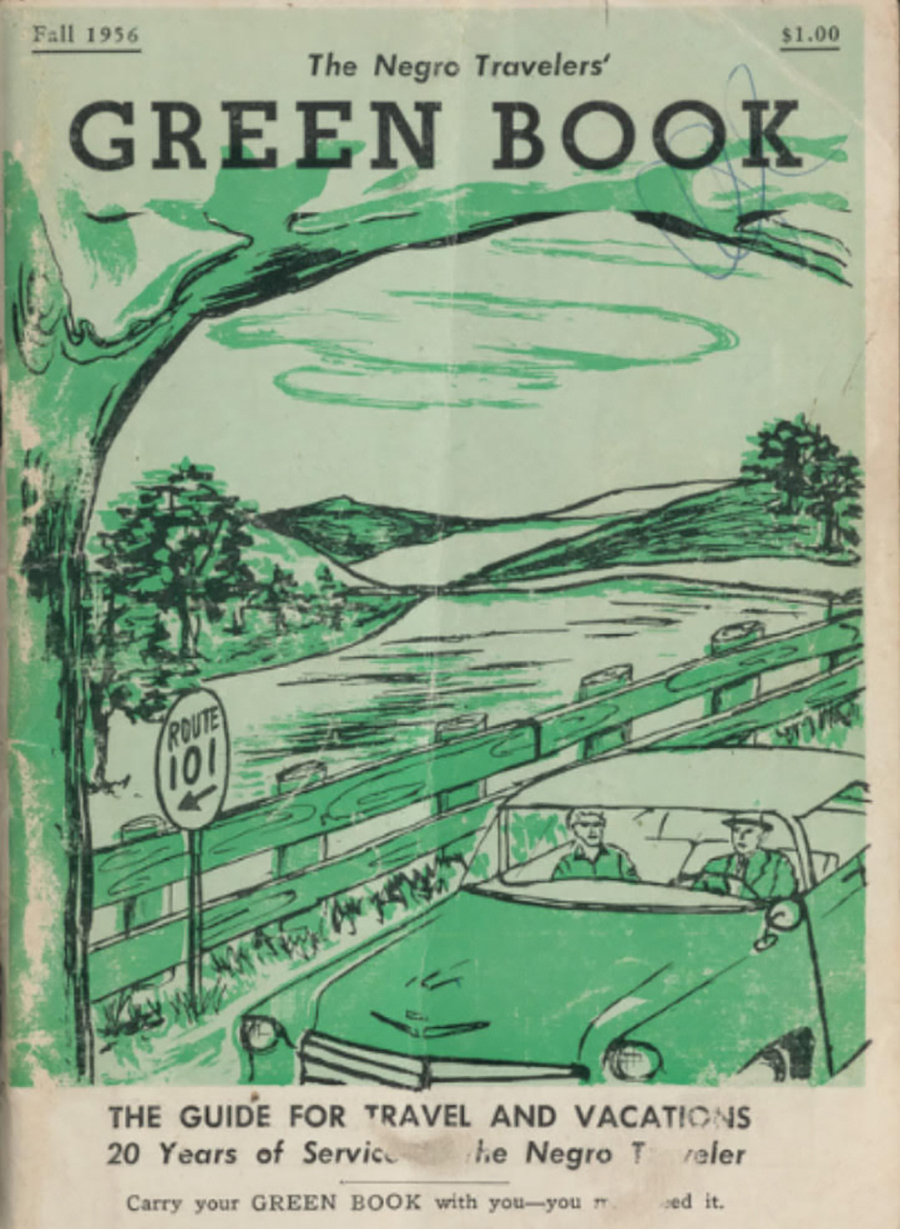
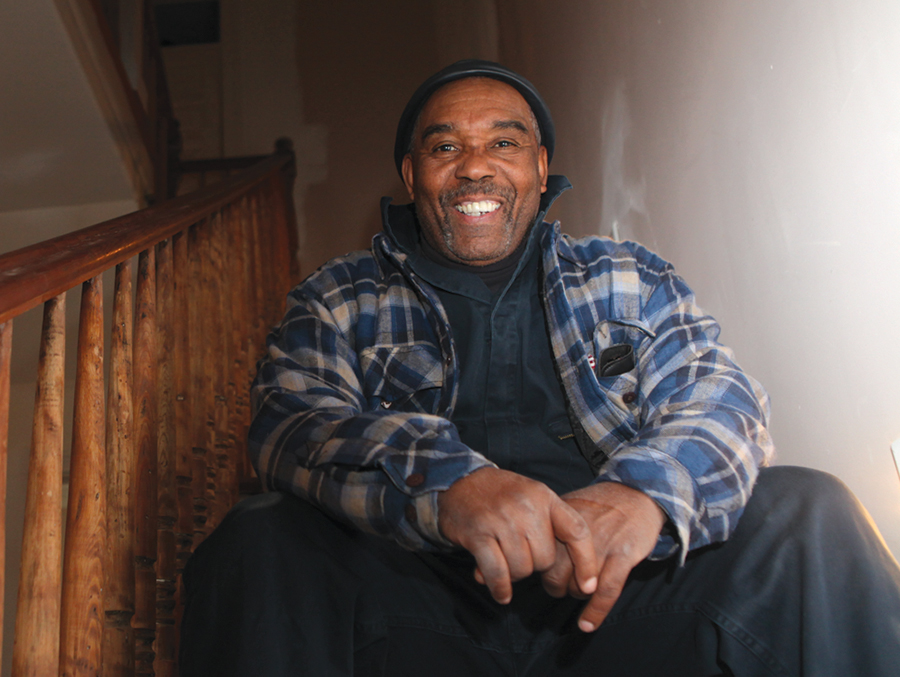

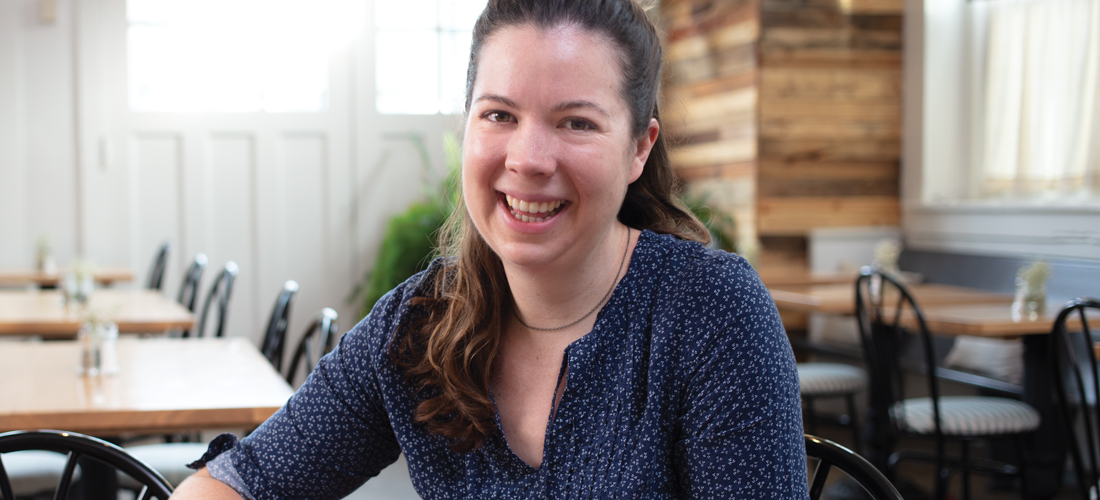
 Cooking Up Change
Cooking Up Change Katei Cranford – Community Advocate
Katei Cranford – Community Advocate Witneigh Davis & Giovanni Ramadani – Founders Greensboro Fashion Week
Witneigh Davis & Giovanni Ramadani – Founders Greensboro Fashion Week  Maurice Hicks – Filmmaker
Maurice Hicks – Filmmaker Jessica Mashburn – Singer, Songwriter
Jessica Mashburn – Singer, Songwriter Savio Nazareth – Head Professional, Starmont Forest Country Club
Savio Nazareth – Head Professional, Starmont Forest Country Club Jessika & Veronika Olsen – Owners, Sonder Mind & Body
Jessika & Veronika Olsen – Owners, Sonder Mind & Body Joe Rotondi – Executive Director, Forge Greensboro
Joe Rotondi – Executive Director, Forge Greensboro